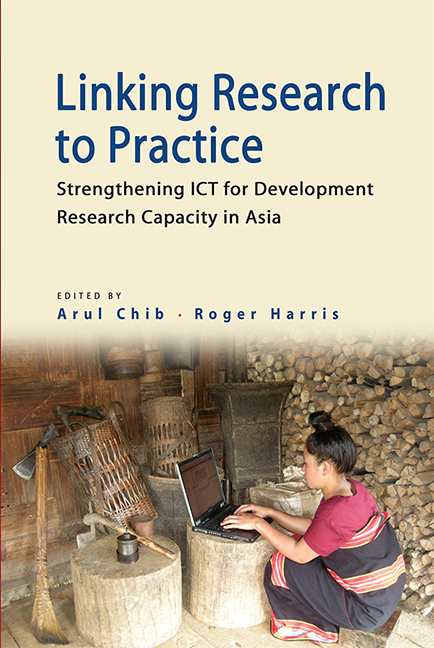Book contents
- Frontmatter
- Contents
- List of Tables
- List of Figures
- Foreword
- Preface
- Acknowledgement
- SECTION I MANAGEMENT PERSPECTIVES: INSIDERS' THOUGHTS ON THE PROGRAMME
- 1 Perspectives on ICTD Research and Practice
- 2 SIRCA: An Opportunity to Build and Improve the Field of ICT4D
- 3 Managing the SIRCA Programme
- 4 Primary Investigator and Mentor Perspectives of SIRCA
- SECTION II RESEARCH PERSPECTIVES: THEORETICAL REFLECTIONS BY EXPERTS
- SECTION III RESEARCH OUTPUTS
- SECTION IV SYNTHESIS AND CONCLUSION
- About the Contributors0
- Index
1 - Perspectives on ICTD Research and Practice
from SECTION I - MANAGEMENT PERSPECTIVES: INSIDERS' THOUGHTS ON THE PROGRAMME
Published online by Cambridge University Press: 21 October 2015
- Frontmatter
- Contents
- List of Tables
- List of Figures
- Foreword
- Preface
- Acknowledgement
- SECTION I MANAGEMENT PERSPECTIVES: INSIDERS' THOUGHTS ON THE PROGRAMME
- 1 Perspectives on ICTD Research and Practice
- 2 SIRCA: An Opportunity to Build and Improve the Field of ICT4D
- 3 Managing the SIRCA Programme
- 4 Primary Investigator and Mentor Perspectives of SIRCA
- SECTION II RESEARCH PERSPECTIVES: THEORETICAL REFLECTIONS BY EXPERTS
- SECTION III RESEARCH OUTPUTS
- SECTION IV SYNTHESIS AND CONCLUSION
- About the Contributors0
- Index
Summary
The role of information and communication technologies (ICTs) towards achieving development (ICTD; sometimes referred to as ICT4D) goals, such as education, gender empowerment, health, and poverty eradication has gained a fair bit of traction (United Nations 2005). ICTD is a general expression in which the term ICTs more often refers to new media technologies such as the internet, computer, mobile phone, global positioning system, but it can also mean more traditional media such as radio, television, and landline telephony. Development is generally regarded as the socio-economic progress of the developing world. There are many variations around these themes, as well as multiple labels describing them. It is not necessary to elaborate on the definitional distinctions here (there are other sources for that) because to do so would plunge us into the very trap for which this volume is intended as an aid in avoiding.
There are a number of high-profile academic studies encapsulating the promise of ICTD, such as rural fishermen in southern India, earning less than US$100 a month, using mobile phones to help decide to which of the several nearby markets to deliver their catch in order to get the best available price (Abraham 2007; Jensen 2007). Or the rural internet centre that saved lives by broadcasting news of the impending tsunami by loud-speaker to the local village community, saving them from drowning in a stormy ocean (Subramanian 2005). Or mobile phones in Bangladesh that benefit entire villages to get connected, whilst providing economic value to the woman entrepreneurs that provide the service (Richardson, Ramirez, and Haq). Or of rural midwives in Indonesia that get connected to urban hospitals via JAVA-enabled mobile applications, improving healthcare services to pregnant village women (Chib 2010). These examples of the use of ICTs are spreading rapidly across the developing world; in some cases this is because of the actions of development practitioners and academics that take an interest in such things, but in many cases they are happening in spite of the actions of such people.
- Type
- Chapter
- Information
- Linking Research to PracticeStrengthening ICT for Development Research Capacity in Asia, pp. 3 - 11Publisher: ISEAS–Yusof Ishak InstitutePrint publication year: 2012



